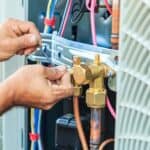Keep Your Plumbing (and Wallet) Healthy
Plumbing problems strike fear into every homeowner. A severe plumbing problem can result in homeowners seeking other accommodation while they pay big money to solve their plumbing issues. Their stress levels skyrocket, and they end up kicking themselves for not doing their plumbing maintenance checks before the situation spiraled.
Sticking to their plumbing maintenance routine would have prevented such a severe case and regret. Our plumbing maintenance checklist should be used every other month to monitor the condition of your plumbing fixtures and catch any problems before they grow larger, (as well as the water bills). It covers all the key areas and elements of your home, what to look out for, and what to do if you spot a problem.
Around The House
Set aside some time to check your plumbing around the house. These elements are situated in different places, from outdoors to the basement, so do your rounds and make sure to pay attention to:
The Water Heater
First on our plumbing maintenance checklist is the water heater. This is responsible for keeping your morning showers and relaxing baths hot. If there’s a fault with your water heater, not only can you end up with no hot water, but you may also be breeding dangerous bacteria that can harm your entire household.
When checking your water heater, keep an eye on your pipes. Check to see if they’re intact, and not leaking. If there’s a leak, look at the color of the water. It should be crystal clear. That said, if the color is a brownish, rusty color, it indicates that dirt and dust has contaminated the water due to an exposed gap in your pipes. This dirt can lead to water infection, which can breed nasty bacteria. This is a serious health concern, so don’t leave it until someone gets sick.
Without routine maintenance checks, there’s a chance that a problem like this will go unnoticed, which could mean infection becomes a problem before the leak. However, if you’re monitoring the condition of your water heater every other month, you can be sure to catch it at the beginning and have it repaired before the water becomes contaminated.
Hose Spigots
You’ll also need to make sure your hose spigots are functioning correctly without any leaks. With old age, spigots commonly develop leaks and it’s essential to be aware of any problems as soon as possible. If not, you could be facing high water bills and soggy flooring.
Unfortunately, this is an element of plumbing that many homeowners ignore. However, as soon as their water bill comes through the mail, they wish they had spent a few minutes checking their hose spigots.
If you spot a leak, you can fix your hose spigots by replacing your cartridges or washers. If caught early, it takes very little time to repair, especially when you compare it to fixing a bad leak that has spiraled out of control.
Washing Machine
Washing machines require routine maintenance, and the checks take only a few moments. Unfortunately, many homeowners wait until there’s a problem with their washing machine to investigate. As with anything, your washing machine will last much longer if taken care of properly.
The next time you’ve started a laundry cycle, check that there’s no water leaking from your washing machine. If there is excess water leaking from the bottom of the device, it can lead to household damage.
If there’s a leak, this is usually due to a loose or faulty drain hose, pump, or a worn-down tub-to-pump hose.
The Bathroom
With so many plumbing fixtures inside your bathroom, the risk for plumbing problems is higher. Add the frequent use from every family member, and the bathroom becomes the room with the highest plumbing issue potential. Therefore, it’s most important that you do your plumbing maintenance checks routinely, focusing on:
The Faucets
In the bathroom, you’ll need to focus most on your bathtub, shower, and sink faucets. These require replacement more than other plumbing fixtures as they’re the faucets that are used most.
Check the faucets for any visible leaks or spills. If the faucets are dripping, you need to remove and replace the washers or cartridges.
Checking the shower or bathtub plumbing is slightly more complicated than other elements on this list because of water supply lines hidden inside the walls, making it impossible to check the pipes for leaks visually. That said, there are ways around it. You’ll need to inspect the room directly below the bathroom, as if there’s a leak, that’s where you’ll spot symptoms. These types of leaks can cause intense damage and lead to a remarkably high water and repair bill, so you must stay on top of it.
You’ll also need to run your faucets and monitor your water pressure. If it feels noticeably weaker than usual or it’s spraying water irregularly, there’s probably a calcium build-up on your aerator. This is easily fixed by removing the aerator and cleaning it manually by soaking it in vinegar. If the build-up is too extreme, it’s best to replace it entirely.
The Drains
How many times have your drains clogged up from hair and soap? All too many. It’s an extremely common problem that most homeowners think only needs fixing once the buildup is noticeable. With daily showers and baths, buildups will likely begin forming after every use. Therefore, treat it preventatively rather than as a solution.
If you are spotting a slower draining time, it’s indicating a buildup in your pipes.
Treating this is simple. Use baking soda and vinegar and pour both ingredients down your plughole. This will clear anything that is blocking the water’s flow. Aim to do this every other month rather than solely when the problem is apparent.
You can also purchase drain unblockers, but baking soda and vinegar work just as well, and both of those ingredients are likely to be in your cupboard. In addition, a drain unblocker can be expensive if you’re using it regularly.
The Toilet
No homeowner wants a broken toilet. In extreme cases, a broken toilet can cause a family to pack up and go somewhere else until it’s repaired. Toilets are used frequently, so it’s important to check their conditions.
Again, you need to look for any leaks spilling water out of your toilet. Check the base carefully, making sure the surrounding flooring is dry.
You should also remove the tank lid and flush the toilet to monitor its water usage and overall condition. If the toilet continues to run after flushing, it’s wasting water. That wasted water is all chargeable, meaning your water bill will show you exactly how much water the toilet has wasted. Avoid these bills by performing plumbing maintenance checks on your toilet every other month to catch any problems early on.
The Kitchen
As with the bathroom, the kitchen is a frequently used room by all family members. Therefore, the plumbing fixtures in the kitchen need routine maintenance checks, looking specifically at:
The Sink
Your kitchen sink has seen it all. From excess food to bleach to washing up liquid, the sink is a hotspot for plumbing problems, and if it goes wrong, it can lead to a pungent smell that will revolve around your entire house.
Buildups in kitchen sinks are all too common. So, ensure water is draining with no blocks by monitoring the speed at which the water flows down the sinkhole.
As with your bathroom drains, it’s better to work routinely than when a problem is visible. So, take some time to clean out the sinkhole with baking soda and vinegar every other month to work away at any developing blockages.
The Faucet
Kitchen faucet problems are the most common plumbing issues of them all. Unfortunately, the problem tends to be spotted when it’s already developed, by which time gallons of water have been wasted.
This is due to not actively looking for leaks in the first place. So, if you put aside a few moments to inspect your kitchen faucet, you can catch any issues at the source. Move the lever back and forth and watch for any leaks or spillages. Then, if needed, replace your faucet. You’ll be saving a lot of money in the long run.
The Garbage Disposal
Faulty drain connections between the dishwasher discharge and the disposer or the disposer discharge and the sink drain are the root causes of problems with your garbage disposal.
There’s a routine plumbing maintenance check you can perform to spot any problems early on. Simply turn on the water and power up your garbage disposal. Next, take a look under your sink for any leakage. If everything is dry, it’s functioning as it should. If there are leaks, there’s a problem that needs repair. Catching it before it develops will make repairing it far easier and quicker.
The Dishwasher
Your last plumbing maintenance check is your dishwasher.
A dishwasher can save a whole lot of time and effort, but there is potential for the plumbing to go wrong and leave you with dirty plates and a higher water bill.
Check your dishwasher every other month by watching and listening to it when it’s cycling. If your dishwasher is filling up too slowly, you probably have a problem with your water supply hose or the valve that controls it.
If it’s draining too slowly, or there’s noticeable water in the bottom of your dishwasher after it’s finished cleaning, you’ll need to look at your water discharge hose to ensure there aren’t any blocks.
Taking time to stay on top of your plumbing maintenance can save you money, time, and panic in the long run. Use this plumbing maintenance checklist every other month and make your pipes, home, and family happy.







